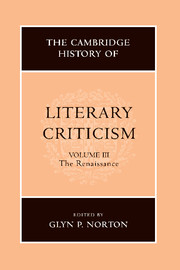Book contents
- Frontmatter
- Introduction
- READING AND INTERPRETATION: AN EMERGING DISCOURSE OF POETICS
- POETICS
- THEORIES OF PROSE FICTION
- 29 Theories of prose fiction in England: 1558–1700
- 30 Theories of prose fiction in sixteenth-century France
- 31 Seventeenth-century theories of the novel in France: writing and reading the truth
- 32 Theories of prose fiction and poetics in Italy: novella and romanzo (1525–1596)
- CONTEXTS OF CRITICISM: METROPOLITAN CULTURE AND SOCIO-LITERARY ENVIRONMENTS
- VOICES OF DISSENT
- STRUCTURES OF THOUGHT
- NEOCLASSICAL ISSUES: BEAUTY, JUDGEMENT, PERSUASION, POLEMICS
- A SURVEY OF NATIONAL DEVELOPMENTS
- Bibliography
- Index
- References
30 - Theories of prose fiction in sixteenth-century France
from THEORIES OF PROSE FICTION
Published online by Cambridge University Press: 28 March 2008
- Frontmatter
- Introduction
- READING AND INTERPRETATION: AN EMERGING DISCOURSE OF POETICS
- POETICS
- THEORIES OF PROSE FICTION
- 29 Theories of prose fiction in England: 1558–1700
- 30 Theories of prose fiction in sixteenth-century France
- 31 Seventeenth-century theories of the novel in France: writing and reading the truth
- 32 Theories of prose fiction and poetics in Italy: novella and romanzo (1525–1596)
- CONTEXTS OF CRITICISM: METROPOLITAN CULTURE AND SOCIO-LITERARY ENVIRONMENTS
- VOICES OF DISSENT
- STRUCTURES OF THOUGHT
- NEOCLASSICAL ISSUES: BEAUTY, JUDGEMENT, PERSUASION, POLEMICS
- A SURVEY OF NATIONAL DEVELOPMENTS
- Bibliography
- Index
- References
Summary
By the time Marguerite de Navarre had completed most of the Heptaméron (1540–5), French Renaissance prose fiction was already very much a porous literary artefact. The fluidity of the form itself – its resistance to definition or reduction to structural uniformity – was fully advertised in the ranging nomenclature by which shorter prose fiction was known to its French readers: devis, récit, conte, histoire, and nouvelle. Largely immune to differentiation, these terms, despite occasional attempts by modern critics to identify taxonomic distinctions, were used almost interchangeably to designate a literary form whose structure, content, and style were rooted not only in the home-grown literary culture of medieval France (the fabliau, profane and largely devoid of moral appeal, and the exemplum, didactic and prescriptive), but in the more crafted aesthetic format of Italian prose fiction, notably Boccaccio's Decameron, where artistic effect seemed frequently to marginalize, if not eclipse, a humanist policy of moral earnestness and sovrasenso. Of special relevance is the fact that unlike Italy and its early Renaissance experimentation (especially in the Decameron) with metrical cadence [cursus] in artistic prose, there is little indication that French prose fiction writers of the fifteenth and sixteenth centuries were able fully to bridge the gap between poetics and the dictamen prosaicum. Theories of prose fiction and the kinds of technical distinctions that one might expect in related critical settings thus found themselves, as will become clear, largely excluded from the poetic arts of writers such as Sebillet, Du Bellay, Peletier du Mans, and Ronsard.
- Type
- Chapter
- Information
- The Cambridge History of Literary Criticism , pp. 305 - 313Publisher: Cambridge University PressPrint publication year: 1999
References
- 1
- Cited by



